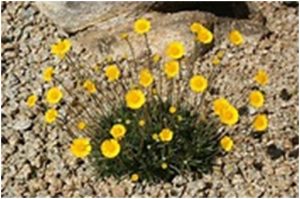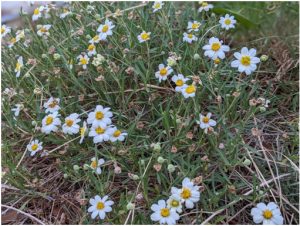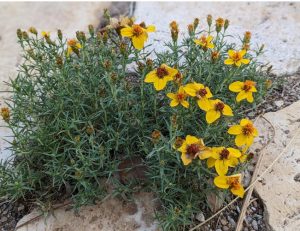By Debbie Roland and
Emmy Ulmschneider
Master Gardeners
In our last article we described four native plants that make wonderful ground covers. Ground covers are usually described as a plant that grows no taller than 6”. But, what about those hard to fill spaces such as along a rock border wall or even in the cracks between pavers, flagstone, or a rock mulch like crushed granite? Here are four native plants that do well in these very hot, dry growing conditions. Although technically not ground covers, these perennial plants will spread or self-seed. They are in the same family, Asteraceae, and have a similar bright, cheerful composite, (daisy-like) flower, typical of this family. And they all thrive in dry hot, low water conditions.

Angelita Daisy (Tetraneuris acaulis) This plant will grow well here when planted in full sun. It is a perennial, cold and heat tolerant, and its yellow blooms appear from spring to early fall. It looks great planted along a path or next to boulders. It can grow up to 12” tall so plan accordingly. We wrote about a related plant which can be used similarly, Tetraneuris scaposa, Four Nerve Daisy in the PBMG blog post on 8/15/2021.
Blackfoot Daisy (Melampodium leucanthum) won’t disappoint you. Its white daisies with yellow centers and dark green foliage will add color to any yard. They appear delicate but are actually very hardy. They can endure high heat and cold winters when planted in full sun. This one will grow up to 12” tall. Avoid overwatering, you can kill it with kindness! In the heat of the summer, when you pick a flower, smell closely for the wonderful whiff of warm honey.

Prairie zinnia (Zinnia grandiflora) If you want a smaller low-growing perennial (6-8”), Prairie Zinnia is the plant for you. When I see the tiny leaves are like a moss like mounds filling the cracks in my flagstone path, I know the numerous yellow blooms are not far behind and will last all summer to the delight of native pollinators. The genus Zinnia, which includes all zinnias, was named in honor of Johann Gottfried Zinnn, a German ophthalmologist and botanist who not only made the early descriptions of the eye brought collected the seeds that would give rise to zinnias. This plant will do best in part shade but very dry soils.

Damiantia (Chrysactinia mexicana) Technically a shrub, but behaves more like an annual flower, this plant is wonderfully drought tolerant. Mine grow 6” to 8” but can grow taller. The bright yellow flower contrasts with the narrow bright green, aromatic leaves. When massed it provides a vivid yellow carpet that provides nectar for pollinators. Grow it in full sun, dry soils and do not overwater. Save the seeds and resow in fall or just let it reseed on its own.
For more information, call the AgriLife office at 498-4071 in Odessa or at 686-4700 in Midland or visit aggie-horticulture.tamu.edu or westtexasgardening.org.




